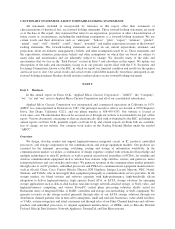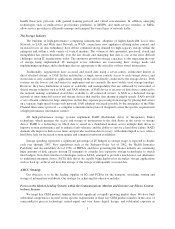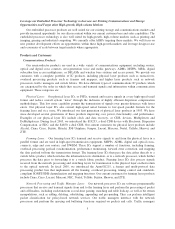3Ware 2005 Annual Report Download - page 8
Download and view the complete annual report
Please find page 8 of the 2005 3Ware annual report below. You can navigate through the pages in the report by either clicking on the pages listed below, or by using the keyword search tool below to find specific information within the annual report.Industry Background
The Communications Industry
Communications technology has evolved considerably over the last several years due to the substantial
growth in the Internet and wireless communications. The emergence of new applications, such as wireless web
devices, voice over Internet Protocol, or VOIP, video-on-demand, third generation, or 3G, wireless services, as
well as the increase in demand for higher speed, higher bandwidth and remote network access, have increased
network bandwidth requirements. The continuing adoption of broadband technology, such as email, instant
messaging and e-commerce, and the increasing availability of next-generation wireless devices that incorporate
features such as internet browsing, cameras and video recorders is expected to drive additional data traffic
through the network infrastructure in the future. The different types of data transmitted at various speeds over the
Internet require service providers and enterprises to invest in multi-service equipment that can efficiently manage
and transport the varied types of network traffic, regardless of whether it is voice traffic or data traffic. To
achieve the performance and functionality required by such systems, OEMs must utilize more complex ICs to
address both the cost and functionality of a system. OEMs must address this need for multi-service equipment
despite reductions in their development teams. As a result of the pace of new product introductions, the
proliferation of standards to be accommodated and the costs and difficulty of designing and producing the
required ICs, equipment suppliers have increasingly outsourced these ICs to semiconductor firms with
specialized expertise. These trends have created a significant opportunity for IC suppliers that can design cost-
effective solutions for the transmission of data. IC suppliers must utilize a variety of skills and technologies to
satisfy the requirements of communications OEMs. These OEMs require IC suppliers that possess system-level
expertise and can quickly bring to market high-performance, highly reliable, power-efficient ICs. These OEMs
seek suppliers with a wide skills base including both analog and digital expertise to provide a more complete
solution that enables faster integration into the system design and higher performance.
The increase in volume and complexity of network traffic has led to the development of new technologies
for more efficient networks. These technologies provide substantially greater transmission capacity, are less error
prone and are easier to maintain than copper networks. These more efficient networks carry high-speed traffic in
the form of electrical and optical signals that are transmitted and received by complex networking equipment. To
ensure that this equipment and the various networks can communicate with each other, OEMs and makers of
semiconductors have developed numerous communications standards and protocols for the industry. For
example, the Synchronous Optical Network, or SONET, standard in North America and Japan and the
Synchronous Data Hierarchy, or SDH, standard in the rest of the world became the standards for the transmission
of signals over optical fiber. The SONET/SDH standards facilitate high data integrity and improved network
reliability, while reducing maintenance and other operation costs by standardizing interoperability among
equipment from different vendors. With data and video traffic being added in abundance to voice traffic,
Asynchronous Transfer Mode, or ATM, emerged as a transmission protocol complementary to SONET/SDH to
optimize bandwidth utilization. Many service providers deploy equipment that handles this protocol because it
can support voice, data, video and multimedia applications simultaneously with the ability to provide quality-of-
service guarantees. With exponential increases in data traffic and very modest increases in voice traffic, data has
become the dominant traffic over all networks today. Internet Protocol, or IP, is another transport protocol that
maintains network information and routes packets across networks. IP packets are larger and can hold more data
than ATM cells, but in some applications may not be able to provide the same quality of service because they are
not optimized for time-sensitive signals such as voice and video. Because of the bandwidth growth and cost
pressures in today’s datacentric networks, more advanced optical networking technologies, such as Dense Wave
Division Multiplexing, or DWDM, have been adopted. DWDM is the optical multiplexing of different
wavelengths of light down a single fiber. Each wavelength is the equivalent of an independent optical channel.
DWDM greatly increases the capacity of installed fiber. Complementing DWDM transmission capabilities are
technologies such as optical Add-Drop Multiplexers, or ADMs, and cross-connects which can more efficiently
switch large optical datapaths through the network. Other protocols, such as multi-protocol label switching, or
MPLS, have emerged that are better suited for data traffic while providing for the low latency and quality of
service needs of voice and video traffic. The SONET/SDH standards have also evolved to more efficiently
2





















